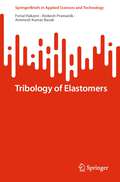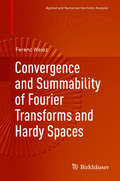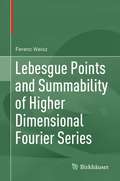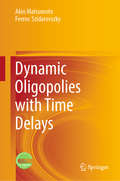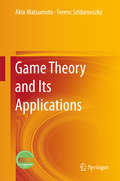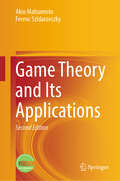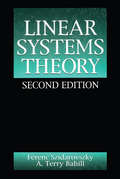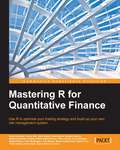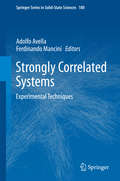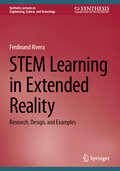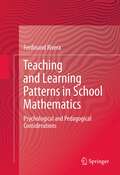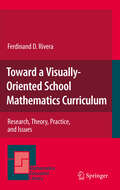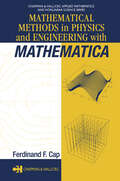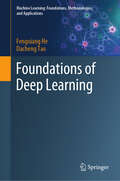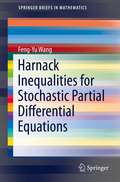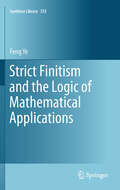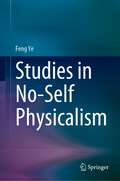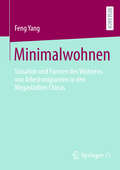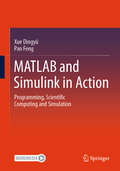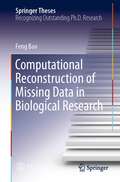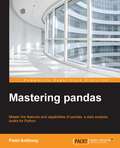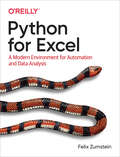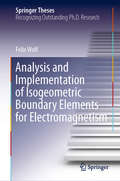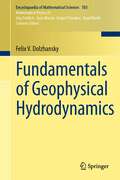- Table View
- List View
Tribology of Elastomers (SpringerBriefs in Applied Sciences and Technology)
by Alokesh Pramanik Ferial Hakami Animesh Kumar BasakThis book highlights the tribological behavior of elastomers by investigating the effect of operating variables such as, the applied load and the abrasive particle size, and the materials’ mechanical properties such as, tensile strength, elongation at break, hardness, and tear strength by the experimental, statistical and analytical methods. It is found that the wear mechanism is mostly friction wear, which is mixed with fatigue wear and abrading under higher applied loads or larger abrasives. The statistical method shows that the abrasive particle size has the highest contribution followed by the applied load on the wear process. Wear equation is developed to predict the wear rate considering the trends of the input variables.
Compound Polyhedra: Modular Origami
by Fergus CurrieA book of ten geometric models of advanced modular origami designed by Fergus Currie with full instructions and diagrams on how to make the following: 1.The Compound of Two Cubes2.The Compound of Two Tetrahedra3.The Compound of the Octahedron and the Cube4.The Compound of Three Cubes5.The Compound of Five Octahedra6.The Compound of Three Octahedra7.The Compound of Three Tetrahedra8.The Compound of the Icosahedron and the Dodecahedron9.The Small Triambic Icosahedron (STI)10.and11.The Compound of the STI and the Dodecahedron.It also includes an introduction with sections on the mathematics behind the models; a short history of modular origami; a section on tools and folding techniques, and a gallery of the finished models that are presented in the book.
Convergence and Summability of Fourier Transforms and Hardy Spaces (Applied and Numerical Harmonic Analysis)
by Ferenc WeiszThe main purpose is to investigate the convergence and summability both of one-dimensional and multi-dimensional Fourier transforms as well as the theory of Hardy spaces. A general summability method, the so called theta-summation, is studied which contains all well known summability methods, such as the Fej#65533;r, Riesz, Weierstrass, Abel, Picard, Bessel and Rogosinski summations. After the classical books of Bary (1964) and Zygmund (1968), this is the first book which considers strong summability treated by current methods. A further novelty of this book is that the Lebesgue points are studied also in the theory of multi-dimensional summability. Besides the classical results, recent results of the last 20-30 years are studied. These results can be found in different research papers the summary of which in a unified context provides the readers a valuable support in their work. The book will be useful for researchers as well as for graduate or postgraduate students. The first two chapters can be used by graduate students and the other ones by PhD students and researchers.
Lebesgue Points and Summability of Higher Dimensional Fourier Series
by Ferenc WeiszThis monograph presents the summability of higher dimensional Fourier series, and generalizes the concept of Lebesgue points. Focusing on Fejér and Cesàro summability, as well as theta-summation, readers will become more familiar with a wide variety of summability methods. Within the theory of higher dimensional summability of Fourier series, the book also provides a much-needed simple proof of Lebesgue’s theorem, filling a gap in the literature. Recent results and real-world applications are highlighted as well, making this a timely resource. The book is structured into four chapters, prioritizing clarity throughout. Chapter One covers basic results from the one-dimensional Fourier series, and offers a clear proof of the Lebesgue theorem. In Chapter Two, convergence and boundedness results for the lq-summability are presented. The restricted and unrestricted rectangular summability are provided in Chapter Three, as well as the sufficient and necessary condition for the norm convergence of the rectangular theta-means. Chapter Four then introduces six types of Lebesgue points for higher dimensional functions. Lebesgue Points and Summability of Higher Dimensional Fourier Series will appeal to researchers working in mathematical analysis, particularly those interested in Fourier and harmonic analysis. Researchers in applied fields will also find this useful.
Dynamic Oligopolies with Time Delays
by Ferenc Szidarovszky Akio MatsumotoThis is the first book to comprehensively examine the asymptotic behavior of dynamic monopolies, duopolies, and oligopolies where firms face information and implementation delays. It considers discrete and continuous timescales, continuously distributed delays, as well as single and multiple delays. It also discusses models with linear and hyperbolic price functions in three types of oligopolies: Cournot competition with quantity-adjusting firms, Bertrand competition with price-adjusting firms, and mixed oligopolies with both types of firms. In addition to the traditional Cournot-Nash equilibria, it introduces cases of partial cooperation are also introduced, leading to the analysis of cartelizing groups of firms and possible governmental actions against antitrust behavior. Further, the book investigates special processes for firms learning about the uncertain price function based on repeated market information. It addresses asymptotic properties of the associated dynamic systems, derives stability conditions, identifies stability switching curves, and presents in global analyses of cases of instability. The book includes both theoretical results and computer studies to illustrate and verify the theoretical findings.
Game Theory and Its Applications
by Ferenc Szidarovszky Akio MatsumotoThis book integrates the fundamentals, methodology, and major application fields of noncooperative and cooperative games including conflict resolution. The topics addressed in the book are discrete and continuous games including games represented by finite trees; matrix and bimatrix games as well as oligopolies; cooperative solution concepts; games under uncertainty; dynamic games and conflict resolution. The methodology is illustrated by carefully chosen examples, applications and case studies which are selected from economics, social sciences, engineering, the military and homeland security. This book is highly recommended to readers who are interested in the in-depth and up-to-date integration of the theory and ever-expanding application areas of game theory.
Game Theory and Its Applications
by Ferenc Szidarovszky Akio MatsumotoThis book integrates the fundamentals, methodology, and major application fields of noncooperative and cooperative games including conflict resolution. The topics addressed in the book are discrete and continuous games including games represented by finite trees; matrix and bimatrix games as well as oligopolies; cooperative solution concepts; games under uncertainty; dynamic games; and conflict resolution. The methodology is illustrated by carefully chosen examples and applications, and the case studies are selected from economics, social sciences, engineering, the military, and homeland security. This book is highly recommended to readers who are interested in the in-depth and up-to-date integration of the theory and ever-expanding application areas of game theory. Dynamic games with and without delays and partial cooperation are added in the 2nd edition.
Linear Systems Theory (Systems Engineering Ser.)
by Ferenc SzidarovszkyThis second edition comprehensively presents important tools of linear systems theory, including differential and difference equations, Laplace and Z transforms, and more.Linear Systems Theory discusses:Nonlinear and linear systems in the state space form and through the transfer function methodStability, including marginal stability, asymptotical stability, global asymptotical stability, uniform stability, uniform exponential stability, and BIBO stabilityControllabilityObservabilityCanonical formsSystem realizations and minimal realizations, including state space approach and transfer function realizationsSystem designKalman filtersNonnegative systemsAdaptive controlNeural networksThe book focuses mainly on applications in electrical engineering, but it provides examples for most branches of engineering, economics, and social sciences.What's New in the Second Edition?Case studies drawn mainly from electrical and mechanical engineering applications, replacing many of the longer case studiesExpanded explanations of both linear and nonlinear systems as well as new problem sets at the end of each chapterIllustrative examples in all the chaptersAn introduction and analysis of new stability conceptsAn expanded chapter on neural networks, analyzing advances that have occurred in that field since the first editionAlthough more mainstream than its predecessor, this revision maintains the rigorous mathematical approach of the first edition, providing fast, efficient development of the material.Linear Systems Theory enables its reader to develop his or her capabilities for modeling dynamic phenomena, examining their properties, and applying them to real-life situations.
Mastering R for Quantitative Finance
by Edina Berlinger Ferenc IllésThis book is intended for those who want to learn how to use R's capabilities to build models in quantitative finance at a more advanced level. If you wish to perfectly take up the rhythm of the chapters, you need to be at an intermediate level in quantitative finance and you also need to have a reasonable knowledge of R.
Strongly Correlated Systems
by Ferdinando Mancini Adolfo AvellaThis volume presents, for the very first time, an exhaustive collection of those modern numerical methods specifically tailored for the analysis of Strongly Correlated Systems. Many novel materials, with functional properties emerging from macroscopic quantum behaviors at the frontier of modern research in physics, chemistry and material science, belong to this class of systems. Any technique is presented in great detail by its own inventor or by one of the world-wide recognized main contributors. The exposition has a clear pedagogical cut and fully reports on the most relevant case study where the specific technique showed to be very successful in describing and enlightening the puzzling physics of a particular strongly correlated system. The book is intended for advanced graduate students and post-docs in the field as textbook and/or main reference, but also for other researchers in the field who appreciate consulting a single, but comprehensive, source or wishes to get acquainted, in a as painless as possible way, with the working details of a specific technique.
STEM Learning in Extended Reality: Research, Design, and Examples (Synthesis Lectures on Engineering, Science, and Technology)
by Ferdinand RiveraThis book synthesizes findings from recent and ongoing research on the use of Extended Reality (XR) to support learning of STEM content. XR is slowly being introduced in classrooms due to significant changes in XR technology. These tools were historically costly, unfriendly, and developed only for gamers. Today, XR tools are able to enhance students’ immersive experiences in such settings. In classrooms, in particular, they provide learners with an opportunity to manipulate abstract objects as if they are physical objects. The book begins with an extensive and detailed description and evaluation of the impact of various XR interventions on learning and engagement in STEM classrooms. The author then concludes with theoretical frameworks for investigating learning in computer- immersive contexts and practical implications for effectively using XR tools to learn STEM.
Teaching and Learning Patterns in School Mathematics
by Ferdinand RiveraThis book synthesizes research findings on patterns in the last twenty years or so in order to argue for a theory of graded representations in pattern generalization. While research results drawn from investigations conducted with different age-level groups have sufficiently demonstrated varying shifts in structural awareness and competence, which influence the eventual shape of an intended generalization, such shifts, however, are not necessarily permanent due to other pertinent factors such as the complexity of patterning tasks. The book proposes an alternative view of pattern generalization, that is, one that is not about shifts or transition phases but graded depending on individual experiences with target patterns. The theory of graded representations involving pattern generalization offers a much more robust understanding of differences in patterning competence since it is sensitive to varying levels of entry into generalization. Empirical evidence will be provided to demonstrate this alternative view, which is drawn from the author's longitudinal work with elementary and middle school children, including several investigations conducted with preservice elementary majors. Two chapters of the book will be devoted to extending pattern generalization activity to arithmetic and algebraic learning of concepts and processes. The concluding chapter addresses the pedagogical significance of pattern learning in the school mathematics curriculum.
Toward a Visually-Oriented School Mathematics Curriculum
by Ferdinand RiveraWhat does it mean to have a visual representation of a mathematical object, concept, or process? What visualization strategies support growth in mathematical thinking, reasoning, generalization, and knowledge? Is mathematical seeing culture-free? How can information drawn from studies in blind subjects help us understand the significance of a multimodal approach to learning mathematics? Toward a Visually-Oriented School Mathematics Curriculum explores a unified theory of visualization in school mathematical learning via the notion of progressive modeling. Based on the author's longitudinal research investigations in elementary and middle school classrooms, the book provides a compelling empirical account of ways in which instruction can effectively orchestrate the transition from personally-constructed visuals, both externally-drawn and internally-derived, into more structured visual representations within the context of a socioculturally grounded mathematical activity. Both for teachers and researchers, a discussion of this topic is relevant in the history of the present. The ubiquity of technological tools and virtual spaces for learning and doing mathematics has aroused interest among concerned stakeholders about the role of mathematics in these contexts. The book begins with a prolegomenon on the author's reflections on past and present visual studies in mathematics education. In the remaining seven chapters, visualization is pursued in terms of its role in bringing about progressions in mathematical symbolization, abduction, pattern generalization, and diagrammatization. Toward a Visually-Oriented School Mathematics Curriculum views issues surrounding visualization through the eyes of a classroom teacher-researcher; it draws on findings within and outside of mathematics education that help practitioners and scholars gain a better understanding of what it means to pleasurably experience the symmetric visual/symbolic reversal phenomenon - that is, seeing the visual in the symbolic and the symbolic in the visual."
Mathematical Methods in Physics and Engineering with Mathematica (Chapman & Hall/CRC Applied Mathematics & Nonlinear Science)
by Ferdinand F. CapMore than ever before, complicated mathematical procedures are integral to the success and advancement of technology, engineering, and even industrial production. Knowledge of and experience with these procedures is therefore vital to present and future scientists, engineers and technologists.Mathematical Methods in Physics and Engineering
Foundations of Deep Learning (Machine Learning: Foundations, Methodologies, and Applications)
by Dacheng Tao Fengxiang HeDeep learning has significantly reshaped a variety of technologies, such as image processing, natural language processing, and audio processing. The excellent generalizability of deep learning is like a “cloud” to conventional complexity-based learning theory: the over-parameterization of deep learning makes almost all existing tools vacuous. This irreconciliation considerably undermines the confidence of deploying deep learning to security-critical areas, including autonomous vehicles and medical diagnosis, where small algorithmic mistakes can lead to fatal disasters. This book seeks to explaining the excellent generalizability, including generalization analysis via the size-independent complexity measures, the role of optimization in understanding the generalizability, and the relationship between generalizability and ethical/security issues. The efforts to understand the excellent generalizability are following two major paths: (1) developing size-independent complexity measures, which can evaluate the “effective” hypothesis complexity that can be learned, instead of the whole hypothesis space; and (2) modelling the learned hypothesis through stochastic gradient methods, the dominant optimizers in deep learning, via stochastic differential functions and the geometry of the associated loss functions. Related works discover that over-parameterization surprisingly bring many good properties to the loss functions. Rising concerns of deep learning are seen on the ethical and security issues, including privacy preservation and adversarial robustness. Related works also reveal an interplay between them and generalizability: a good generalizability usually means a good privacy-preserving ability; and more robust algorithms might have a worse generalizability. We expect readers can have a big picture of the current knowledge in deep learning theory, understand how the deep learning theory can guide new algorithm designing, and identify future research directions. Readers need knowledge of calculus, linear algebra, probability, statistics, and statistical learning theory.
Harnack Inequalities for Stochastic Partial Differential Equations
by Feng-Yu WangIn this book the author presents a self-contained account of Harnack inequalities and applications for the semigroup of solutions to stochastic partial and delayed differential equations. Since the semigroup refers to Fokker-Planck equations on infinite-dimensional spaces, the Harnack inequalities the author investigates are dimension-free. This is an essentially different point from the above mentioned classical Harnack inequalities. Moreover, the main tool in the study is a new coupling method (called coupling by change of measures) rather than the usual maximum principle in the current literature.
Strict Finitism and the Logic of Mathematical Applications
by Feng YeThis book intends to show that radical naturalism (or physicalism), nominalism and strict finitism account for the applications of classical mathematics in current scientific theories. The applied mathematical theories developed in the book include the basics of calculus, metric space theory, complex analysis, Lebesgue integration, Hilbert spaces, and semi-Riemann geometry (sufficient for the applications in classical quantum mechanics and general relativity). The fact that so much applied mathematics can be developed within such a weak, strictly finitistic system, is surprising in itself. It also shows that the applications of those classical theories to the finite physical world can be translated into the applications of strict finitism, which demonstrates the applicability of those classical theories without assuming the literal truth of those theories or the reality of infinity. Both professional researchers and students of philosophy of mathematics will benefit greatly from reading this book.
Studies in No-Self Physicalism
by Feng YeThis book demonstrates how a radical version of physicalism (‘No-Self Physicalism’) can offer an internally coherent and comprehensive philosophical worldview. It first argues that a coherent physicalist should explicitly treat a cognitive subject merely as a physical thing and should not vaguely assume an amorphous or even soul-like subject or self. This approach forces the physicalist to re-examine traditional core philosophical notions such as truth, analyticity, modality, apriority because our traditional understandings of them appear to be predicated on a cognitive subject that is not literally just a physical thing.In turn, working on the assumption that a cognitive subject is itself completely physical, namely a neural network-based robot programmed by evolution (hence the term ‘No-Self’), the book proposes physicalistic theories on conceptual representation, truth, analyticity, modality, the nature of mathematics, epistemic justification, knowledge, apriority and intuition, as well as a physicalistic ontology. These are meant to show that this No-Self Physicalism, perhaps the most minimalistic and radical version of physicalism proposed to date, can accommodate many aspects that have traditionally interested philosophers. Given its refreshingly radical approach and painstakingly developed content, the book is of interest to anyone who is seeking a coherent philosophical worldview in this age of science.
Minimalwohnen: Situation und Formen des Wohnens von Arbeitsmigranten in den Megastädten Chinas
by Feng YangIm Zuge der Urbanisierung wird die Stadtbevölkerung bis 2050 weltweit um 2,5 Milliarden Menschen zunehmen. In China, dem Land mit der größten Stadtbevölkerung der Welt, wanderten bis 2016 136 Millionen vom Land in die Städte. An diesem Fall wird gezeigt, wie sich die Unterbringung entwickelte: auf der Ebene der städtebaulichen Eingliederung, der Wohnumgebung, der Gebäude und Wohneinheit. Das Wohnen der Arbeitsmigranten wird im Kontext von Chinas einzigartigem Hukou-System sowie seiner Boden- und Wohnpolitik analysiert. Typische Fälle in Peking, Shanghai und Guangzhou werden auf der Grundlage neu erstellter Typologie ihrer Wohnformen untersucht. Als Methode wird neben Befragen, Messen, Dokumentieren die teilnehmende Beobachtung benutzt. Der Autor wohnte in einer Art „Selbstversuch“ in den untersuchten Typen. Empfehlungen beziehen sich auf politische, stadtplanerische und bauliche Maßnahmen für bestehende sowie neu zu bauende Wohnräume für Arbeitsmigranten. China ist ein besonderer Fall - seine Lösungsansätze können den internationalen Diskurs anreichern, der über die Unterbringung der weltweiten Migrantenströme geführt wird.
MATLAB and Simulink in Action: Programming, Scientific Computing and Simulation
by Dingyü Xue Feng PanThe textbook is intended for teaching MATLAB language and its applications. The book is composed of three parts: MATLAB programming, scientific computing with MATLAB, and system simulation with Simulink. Since MATLAB is widely used in all fields of science and engineering, a good introduction to the language can not only help students learn how to use it to solve practical problems, but also provide them with the skills to use MATLAB independently in their later courses and research. The three parts of the book are well-balanced and tailored to the needs of engineering students, and the mathematical problems commonly encountered in engineering can be easily solved using MATLAB. This textbook is suitable for undergraduate and graduate students majoring in science and engineering.
Computational Reconstruction of Missing Data in Biological Research (Springer Theses)
by Feng BaoThe emerging biotechnologies have significantly advanced the study of biological mechanisms. However, biological data usually contain a great amount of missing information, e.g. missing features, missing labels or missing samples, which greatly limits the extensive usage of the data. In this book, we introduce different types of biological data missing scenarios and propose machine learning models to improve the data analysis, including deep recurrent neural network recovery for feature missings, robust information theoretic learning for label missings and structure-aware rebalancing for minor sample missings. Models in the book cover the fields of imbalance learning, deep learning, recurrent neural network and statistical inference, providing a wide range of references of the integration between artificial intelligence and biology. With simulated and biological datasets, we apply approaches to a variety of biological tasks, including single-cell characterization, genome-wide association studies, medical image segmentations, and quantify the performances in a number of successful metrics.The outline of this book is as follows. In Chapter 2, we introduce the statistical recovery of missing data features; in Chapter 3, we introduce the statistical recovery of missing labels; in Chapter 4, we introduce the statistical recovery of missing data sample information; finally, in Chapter 5, we summarize the full text and outlook future directions. This book can be used as references for researchers in computational biology, bioinformatics and biostatistics. Readers are expected to have basic knowledge of statistics and machine learning.
Mastering pandas
by Femi AnthonyThis book is intended for Python programmers, mathematicians, and analysts who already have a basic understanding of Python and wish to learn about its data analysis capabilities in depth.
Python for Excel: A Modern Environment For Automation And Data Analysis
by Felix ZumsteinWhile Excel remains ubiquitous in the business world, recent Microsoft feedback forums are full of requests to include Python as an Excel scripting language. In fact, it's the top feature requested. What makes this combination so compelling? In this hands-on guide, Felix Zumstein--creator of xlwings, a popular open source package for automating Excel with Python--shows experienced Excel users how to integrate these two worlds efficiently.Excel has added quite a few new capabilities over the past couple of years, but its automation language, VBA, stopped evolving a long time ago. Many Excel power users have already adopted Python for daily automation tasks. This guide gets you started.Use Python without extensive programming knowledgeGet started with modern tools, including Jupyter notebooks and Visual Studio codeUse pandas to acquire, clean, and analyze data and replace typical Excel calculationsAutomate tedious tasks like consolidation of Excel workbooks and production of Excel reportsUse xlwings to build interactive Excel tools that use Python as a calculation engineConnect Excel to databases and CSV files and fetch data from the internet using Python codeUse Python as a single tool to replace VBA, Power Query, and Power Pivot
Analysis and Implementation of Isogeometric Boundary Elements for Electromagnetism (Springer Theses)
by Felix WolfThis book presents a comprehensive mathematical and computational approach for solving electromagnetic problems of practical relevance, such as electromagnetic scattering and the cavity problems. After an in-depth introduction to the mathematical foundations of isogeometric analysis, which discusses how to conduct higher-order simulations efficiently and without the introduction of geometrical errors, the book proves quasi-optimal approximation properties for all trace spaces of the de Rham sequence, and demonstrates inf-sup stability of the isogeometric discretisation of the electric field integral equation (EFIE). Theoretical properties and algorithms are described in detail. The algorithmic approach is, in turn, validated through a series of numerical experiments aimed at solving a set of electromagnetic scattering problems. In the last part of the book, the boundary element method is combined with a novel eigenvalue solver, a so-called contour integral method. An algorithm is presented, together with a set of successful numerical experiments, showing that the eigenvalue solver benefits from the high orders of convergence offered by the boundary element approach. Last, the resulting software, called BEMBEL (Boundary Element Method Based Engineering Library), is reviewed: the user interface is presented, while the underlying design considerations are explained in detail. Given its scope, this book bridges an important gap between numerical analysis and engineering design of electromagnetic devices.
Fundamentals of Geophysical Hydrodynamics
by Boris Khesin E. B. Gledzer Felix V. Dolzhansky A. E. GledzerThis newly-translated book takes the reader from the basic principles and conservation laws of hydrodynamics to the description of general atmospheric circulation. Among the topics covered are the Kelvin, Ertel and Rossby-Obukhov invariants, quasi-geostrophic equation, thermal wind, singular Helmholtz vortices, derivation of the Navier-Stokes equation, Kolmogorov's flow, hydrodynamic stability, and geophysical boundary layers. Generalizing V. Arnold's approach to hydrodynamics, the author ingeniously brings in an analogy of Coriolis forces acting on fluid with motion of the Euler heavy top and shows how this is used in the analysis of general atmospheric circulation. This book is based on popular graduate and undergraduate courses given by F.V.Dolzhansky at the Moscow Institute of Physics and Technology, and is the result of the author's highly acclaimed work in Moscow's Laboratory of Geophysical Hydrodynamics. Each chapter is full of examples and figures, exercises and hints, motivating and illustrating both theoretical and experimental results. The exposition is comprehensive yet user-friendly in engaging and exploring the broad range of topics for students and researchers in mathematics, physics, meteorology and engineering.
